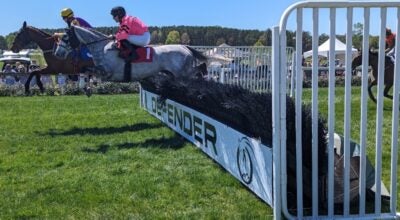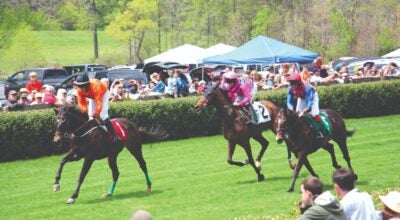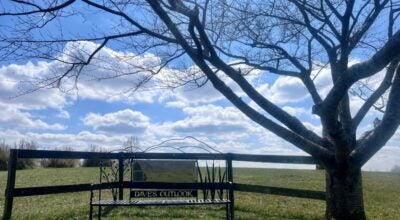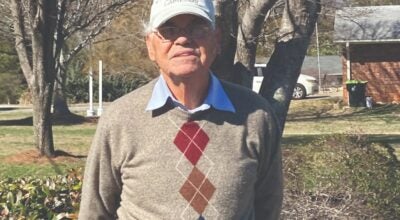Biggest, Best & Most Beneficial
Published 11:37 am Tuesday, August 4, 2015
Life In Our Foothills, November 2014
by Judy Heinrich
Photos by Lou Smith
The horse world has been talking about the Tryon area in superlatives for decades, recognizing our scenic beauty, temperate climate, miles of trails, multiple show venues, and enough local vets, trainers, farriers, and feed and tack stores to meet anyone’s needs. The recent addition of Tryon International Equestrian Center promises to raise our profile even higher.
But one of our long-running equine activities has not yet received its due as the gem it really is for both our equestrian contingent and community at large.
Running continuously for more than 26 years, the Western Carolina Hunter Pace Series is the largest combined HP series in the US and possibly the world. For at least a decade it has hosted 18 events each September through May. A lot of Googling and other research fails to turn up anything comparable in size, scope and history.
Beyond the fun for riders, the WCH Pace Series also serves a more important purpose: With each event benefiting a local non-profit, the series has provided the means for hundreds of thousands of dollars in charitable contributions to be made over the years. Such worthwhile organizations as Big Brothers/Big Sisters, Steps to Hope, Polk County 4H, the Southeastern Children’s Home, FENCE, Foothills Humane Society, Polk Equine Emergency Rescue (PEER), area Pony Clubs, therapeutic riding organizations and many others have been recipients.
Making the tale even more amazing is that one local couple – Jan and Lou Smith – have been coordinating and photographing the series, on a voluntary basis, for almost its entire history.
Backstory
Like our local trail systems, the WCH Pace Series evolved from area foxhunts. At the end of hunt seasons back in the late 1980s, members of the Tryon Hounds, Green Creek Hounds and Greenville County Hounds created a series of joint rides, paced like foxhunts but without the hounds, as something to do during off-season.
Each hunt hosted two individual “Hunter Pace” rides, and trophies were traded back and forth. Other groups then joined in, like Pony Club, FENCE and Biltmore.
Initially, local distance rider and hunt member Barbara Madill organized the events. After going it alone for a time she realized she should probably train a back-up in case she had to miss an event. Into that role stepped Jan Smith, who Barbara had met and become friends with through endurance and competitive trail riding.
Jan is a lifelong horse lover who took every opportunity to ride as a child but didn’t get a “pony” of her own until she was grown and married to Lou. In fact, Lou wanted to be the one to buy Jan her first horse but instead gave the honor to her father, who regretted never being able to do it when Jan was a child. Lou settled for buying all the tack.
Jan’s first horse was an Arab-Appaloosa cross mare and Lou soon got a QH stallion followed by a Tennessee Walking Horse. Jan happened to ride the Walker one day when she put an inexperienced friend on her own bombproof Appaloosa. That’s when Jan, who had a touch of arthritis, realized that she could ride longer and more comfortably on a gaited horse.
Researching gaited breeds led her to Paso Finos. She and Lou went to some shows and met a Maryland breeder who sold them a mare for Jan and, later, one for Lou.
It was attending another Paso Fino show, this one at the Ag Center in Fletcher, that first brought them to Western North Carolina. They had been talking about relocating from New Jersey and fell in love with the Tryon area. They moved here in 1989, with Lou going to work for GE in Greenville and Jan hanging out her bookkeeping shingle.
It wasn’t long before Jan was attending the new Hunter Paces, “riding my gaited Paso Fino with a flat seat saddle and wearing culottes,” she remembers.
About a year in, when Barbara Madill’s husband retired and they began traveling more often, Jan officially took the coordination reins.
WCH Pace Evolution
“Back in the early days 35 riders was considered a big ride,” Jan says. “Now we average 100 riders at each event and have had more than 200 at some of the FENCE rides.”
The entry fee for the earliest HPs was usually $20-25, which has increased to $35-$40 now. Jan collects a “sanctioning fee” – a small percent of each rider’s entry – to use primarily for website costs and year-end awards.
Along with coordinating the events since 1990, Jan also began promoting them wherever she could. Since one of Lou’s hobbies was photography, she enlisted him to take some shots to share with the Tryon Daily Bulletin and other publications. She also handed out business cards and liberally used her connections in competitive trail and endurance circles to spread the word.
Promotion snowballed with the arrival of email and the Internet. Jan actually learned code so she could build the first WCH Pace website. Its introduction spurred new demand for photos, so Lou’s role expanded from a few publicity pictures to taking action shots of just about every rider there. Photos are posted on the website and digital files have made it easier for people to order and receive theirs.
Two important things made Jan’s website work easier: technology enabled the move to a more design-friendly platform and a saint of an HP rider – Brian MacCormack – offered to take over website responsibilities. Brian created and handles the technical end of the new wchpace.org.
Meanwhile, Jan works about 20 hours a week during HP season to organize the series and support the success of individual events. Following each event she collects all the completion times of individual riders and teams and calculates placements for the different categories: Field Hunter, (riding at a faster, hunt-type pace) and Trail Rider (a more leisurely pace).
The sponsoring organization for each pace is responsible for all on-site work: choosing and marking their trails; timing the Field Hunter course; organizing parking areas and volunteers; collecting registrations, waivers and entry fees; hosting lunch for everyone; removing trail markers, and a whole lot more.
To help sponsors with the many steps, Jan created an “Organizers Notes” summary. And in spite of the work involved, there is no lack of sponsoring organizations: Jan has a waiting list of groups for any dates that might open up.
Now Jan is extremely happy to spend her on-site time up on a horse herself. Following a five-year break after retiring her long-time partner, she’s back in the action on Paso Fino gelding “Magic.”
The Pace in On!
With the 2014-15 WCH Pace Series getting underway in September, the number of horse trailers on the roads rises dramatically two Sundays (and an occasional Saturday) each month. Most are heading to venues in Polk and Spartanburg Counties, with forays to Biltmore, Clemson and Cleveland County.
Riding in those trailers are Hunter Pace horses of all kinds, from traditional foxhunter-y Thoroughbreds, Warmbloods and ponies, to stock horse breeds, Gypsy Vanners, drafts, many types of gaited horses and a handful of mules.
Likewise, rider dress runs the gamut from traditional English breeches to Western jeans and cowboy boots, not to mention full costumes at the annual Green Creek Hounds Halloween event.
All the riders are happy to be enjoying good fun, good company and beautiful trails that are often privately owned and otherwise unavailable. Knowing that they’re supporting worthwhile organizations at the same time adds to the pleasure.
If you’re an HP rider (or want to be), do this one little thing: the next time you see Jan and Lou, thank them for all their hard work in making our WCH Pace Series the biggest, best and most beneficial of all. It surely wouldn’t have happened without them.






